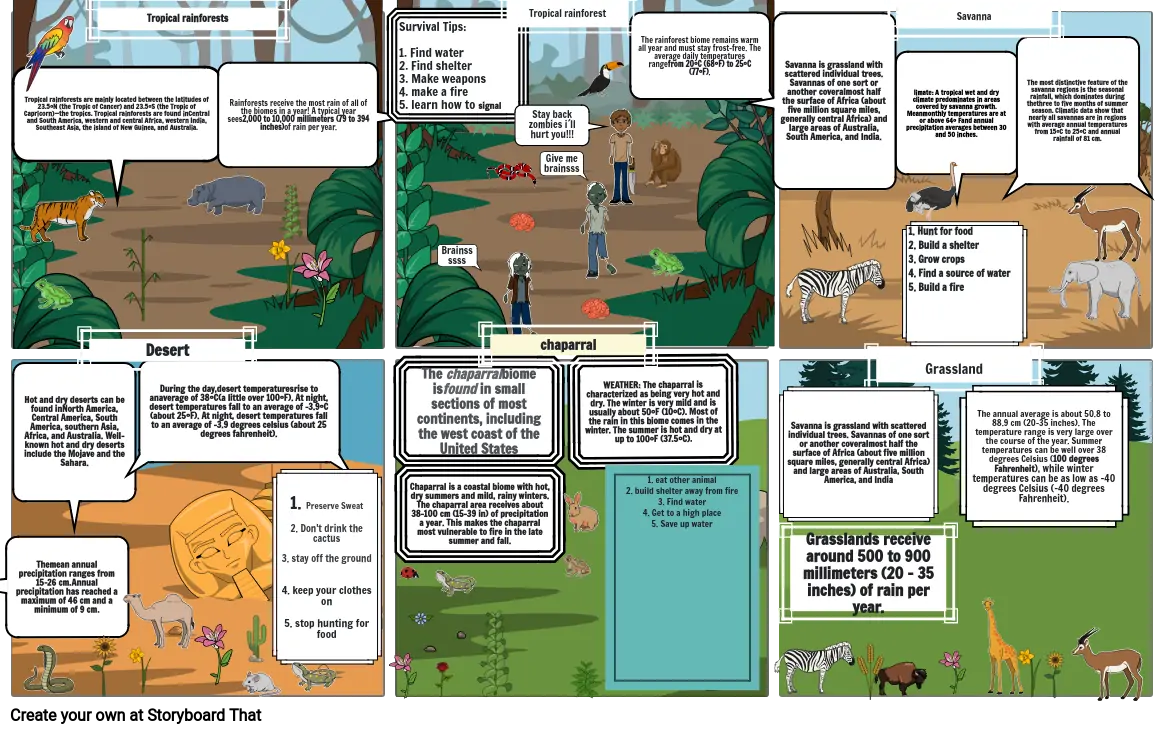Unknown Story

Storyboard Text
- Tropical rainforests are mainly located between the latitudes of 23.5°N (the Tropic of Cancer) and 23.5°S (the Tropic of Capricorn)—the tropics. Tropical rainforests are found in Central and South America, western and central Africa, western India, Southeast Asia, the island of New Guinea, and Australia.
- Desert
- Tropical rainforests
- Survival Tips: 1. Find water2. Find shelter 3. Make weapons 4. make a fire5. learn how to signal
- Rainforests receive the most rain of all of the biomes in a year! A typical year sees 2,000 to 10,000 millimeters (79 to 394 inches) of rain per year.
- Brainssssss
- chaparral
- Tropical rainforest
- Give me brainsss
- Stay back zombies i´ll hurt you!!!
- The rainforest biome remains warm all year and must stay frost-free. The average daily temperatures range from 20°C (68°F) to 25°C (77°F).
- Savanna is grassland with scattered individual trees. Savannas of one sort or another cover almost half the surface of Africa (about five million square miles, generally central Africa) and large areas of Australia, South America, and India.
- Grassland
- Savanna
- limate: A tropical wet and dry climate predominates in areas covered by savanna growth. Mean monthly temperatures are at or above 64° F and annual precipitation averages between 30 and 50 inches.
- 1. Hunt for food2. Build a shelter3. Grow crops4. Find a source of water5. Build a fire
- The most distinctive feature of the savanna regions is the seasonal rainfall, which dominates during the three to five months of summer season. Climatic data show that nearly all savannas are in regions with average annual temperatures from 15°C to 25°C and annual rainfall of 81 cm.
- The mean annual precipitation ranges from 15-26 cm. Annual precipitation has reached a maximum of 46 cm and a minimum of 9 cm.
- During the day, desert temperatures rise to an average of 38°C (a little over 100°F). At night, desert temperatures fall to an average of -3.9°C (about 25°F). At night, desert temperatures fall to an average of -3.9 degrees celsius (about 25 degrees fahrenheit).
- Hot and dry deserts can be found in North America, Central America, South America, southern Asia, Africa, and Australia. Well-known hot and dry deserts include the Mojave and the Sahara.
- 1. Preserve Sweat2. Don't drink the cactus 3. stay off the ground4. keep your clothes on 5. stop hunting for food
- The chaparral biome is found in small sections of most continents, including the west coast of the United States
- Chaparral is a coastal biome with hot, dry summers and mild, rainy winters. The chaparral area receives about 38–100 cm (15–39 in) of precipitation a year. This makes the chaparral most vulnerable to fire in the late summer and fall.
- 1. eat other animal2. build shelter away from fire3. Find water 4. Get to a high place 5. Save up water
- WEATHER: The chaparral is characterized as being very hot and dry. The winter is very mild and is usually about 50°F (10°C). Most of the rain in this biome comes in the winter. The summer is hot and dry at up to 100°F (37.5°C).
- Grasslands receive around 500 to 900 millimeters (20 – 35 inches) of rain per year.
- Savanna is grassland with scattered individual trees. Savannas of one sort or another cover almost half the surface of Africa (about five million square miles, generally central Africa) and large areas of Australia, South America, and India
- The annual average is about 50.8 to 88.9 cm (20-35 inches). The temperature range is very large over the course of the year. Summer temperatures can be well over 38 degrees Celsius (100 degrees Fahrenheit), while winter temperatures can be as low as -40 degrees Celsius (-40 degrees Fahrenheit).
Over 30 Million Storyboards Created

